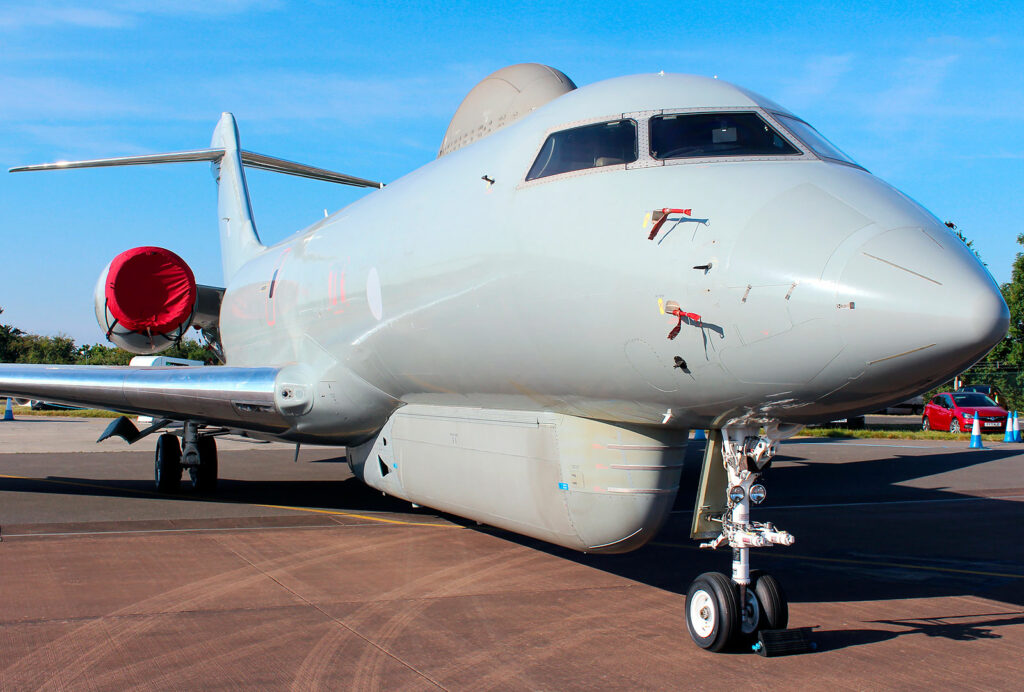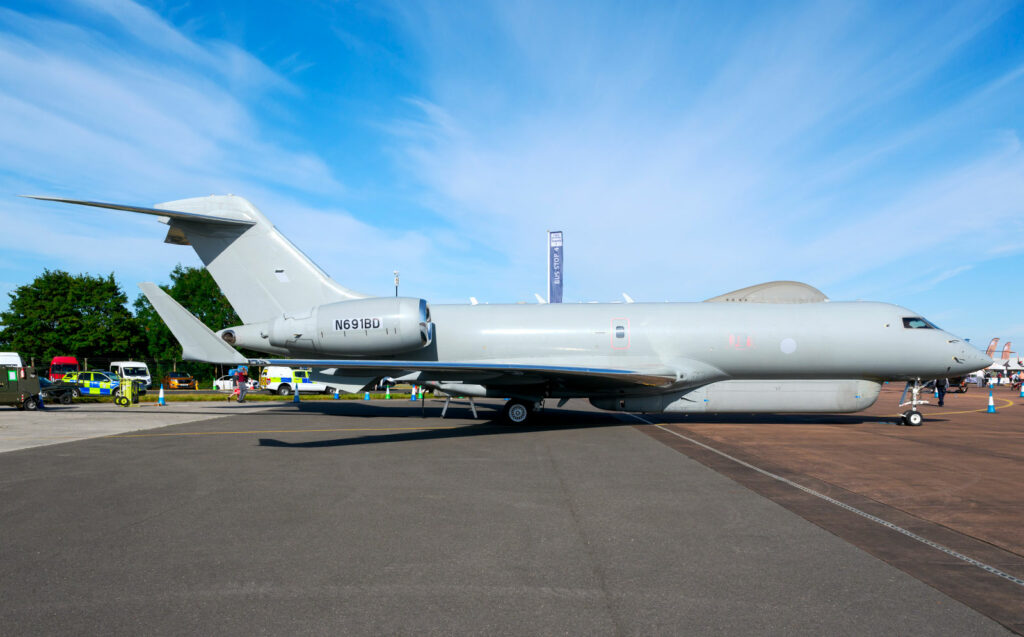Bombardier Raytheon Sentinel: high-altitude surveillance aircraft for wide-area battlefield surveillance and reconnaissance.
In Brief
The Bombardier Raytheon Sentinel is an airborne battlefield and reconnaissance aircraft, modified from the Bombardier Global Express business jet. It features high-altitude, long-endurance capabilities for real-time surveillance, providing intelligence on battlefield movements over vast areas. Equipped with the Advanced Synthetic Aperture Radar System (ASTOR), it delivers high-resolution imagery and ground target tracking. The Sentinel can operate at a cruising altitude of 49,000 feet (14,935 meters) with a maximum range of 5,800 miles (9,334 kilometers). Used primarily by the UK Royal Air Force, the aircraft’s modular design allows for flexibility in various mission profiles.

The Bombardier Raytheon Sentinel
The Bombardier Raytheon Sentinel was developed to provide the United Kingdom with a robust airborne intelligence platform. As conflicts evolved towards asymmetric warfare, the need for precise, long-range surveillance grew significantly. The Sentinel emerged as a solution to this demand, offering real-time, all-weather battlefield reconnaissance. Its development marked a shift towards utilizing advanced radar systems and high-altitude platforms to enhance situational awareness for ground forces. First flown in 2004, the Sentinel has since become a crucial asset for the UK’s intelligence and reconnaissance capabilities.
History of the Development of the Bombardier Raytheon Sentinel
In the late 1990s, the UK Ministry of Defence (MoD) recognized the increasing importance of real-time battlefield intelligence. The changing nature of warfare underscored the need for an airborne platform capable of wide-area surveillance, especially as operations moved into challenging terrains like deserts and mountainous regions. Thus, the Airborne Stand-Off Radar (ASTOR) program was born, with the objective of creating a high-altitude, long-endurance aircraft that could perform persistent surveillance and relay actionable intelligence to ground commanders.
The ASTOR program officially began in 1999, with the MoD awarding a contract to Raytheon for the development of the radar system. Raytheon selected Bombardier’s Global Express business jet as the airframe, due to its high-altitude capability, endurance, and reliability. Bombardier’s platform was well-suited for modification, offering ample space for the required surveillance equipment and support systems. The development process involved extensive collaboration between Raytheon and Bombardier, with Raytheon overseeing the integration of the ASTOR system.
The first Sentinel R1 aircraft took flight in 2004, testing its radar capabilities and confirming its suitability for surveillance missions. It entered operational service with the UK Royal Air Force in 2008. During its development, the Sentinel was equipped with advanced radar technology capable of both Synthetic Aperture Radar (SAR) and Moving Target Indication (MTI), allowing it to monitor and track ground movements over large areas. This capability was crucial for supporting ground operations, particularly in the context of the UK’s involvement in Afghanistan.
The Sentinel is commonly referred to by its NATO designation, R1. Over the years, it has played a vital role in various operations, including Operation Herrick in Afghanistan and Operation Shader in Iraq and Syria. Its introduction marked a significant enhancement in the UK’s intelligence-gathering capabilities, filling a niche that other platforms, such as drones or satellite systems, could not fully address due to limitations in endurance and real-time data relay. The program underscored the MoD’s commitment to leveraging cutting-edge technology to maintain strategic advantages in modern combat environments.
Design of the Bombardier Raytheon Sentinel
The Sentinel’s design leverages the Bombardier Global Express airframe, a choice driven by the jet’s high-altitude and long-range capabilities. The aircraft measures 99.4 feet (30.3 meters) in length with a wingspan of 94 feet (28.7 meters), providing a spacious fuselage for integrating surveillance equipment. The airframe’s structural integrity allows the aircraft to operate at altitudes up to 49,000 feet (14,935 meters), which is essential for both avoiding ground threats and optimizing the radar’s range.
The aircraft’s most distinguishing feature is the radome on its underside, housing the Raytheon ASTOR radar system. This radar provides all-weather, day-and-night surveillance, using Synthetic Aperture Radar (SAR) for detailed ground imagery and Moving Target Indicator (MTI) capabilities to track moving objects. The SAR provides high-resolution images that are crucial for identifying stationary targets, while the MTI system tracks movement across large swathes of terrain. This combination allows the Sentinel to perform wide-area surveillance effectively.
Internally, the Sentinel is equipped with sophisticated onboard processing systems, enabling it to analyze and disseminate data in real-time. The aircraft can transmit information directly to ground stations, ensuring rapid response to emerging threats. The cockpit and control systems are modified to support these specialized functions, with workstations for mission operators who control the radar and analyze data during flights.
The aircraft is powered by two Rolls-Royce BR700 turbofan engines, each providing 14,750 pounds (6,690 kg) of thrust. This power supports the aircraft’s extended endurance, with missions lasting up to nine hours. The engines are known for their fuel efficiency, which enhances the Sentinel’s ability to perform long-duration sorties.
The design includes an advanced cooling system to manage the heat generated by the radar and onboard electronics. Despite its advanced capabilities, the aircraft faces limitations in terms of payload capacity, which is focused primarily on the radar system, limiting flexibility for other mission-specific equipment. Nevertheless, the aircraft’s design successfully balances performance, endurance, and specialized ISR capabilities.
Performance of the Bombardier Raytheon Sentinel
The Sentinel R1’s performance is driven by its Rolls-Royce BR700 engines, which deliver a combined thrust of 29,500 pounds (13,380 kg). This setup enables the aircraft to reach speeds of up to 541 miles per hour (870 km/h) at cruising altitude, with a maximum operational altitude of 49,000 feet (14,935 meters). These attributes allow the Sentinel to maintain high speeds and altitudes, minimizing its vulnerability to ground-based threats.
The aircraft’s range is a significant advantage, capable of covering distances of 5,800 miles (9,334 kilometers) on a single mission. This range allows it to patrol large areas or remain on station over target zones for extended periods. The aircraft typically cruises at around 470 miles per hour (756 km/h), a speed that provides a balance between endurance and the ability to respond swiftly to operational demands.
Compared to other surveillance aircraft, the Sentinel offers a combination of high altitude and long endurance, which is less common among its peers. For example, the Northrop Grumman E-8 Joint STARS, another high-profile surveillance platform, operates at lower altitudes and is limited by a range of around 2,500 miles (4,023 kilometers). The Sentinel’s superior range enables it to conduct missions with fewer logistical constraints, offering strategic flexibility for mission planners.
However, the Sentinel is not without its limitations. Its reliance on an external radome for radar capabilities results in a detectable radar cross-section, which limits its use in highly contested airspaces. Despite this, the Sentinel remains one of the UK’s most capable ISR platforms, offering a unique combination of altitude, endurance, and advanced radar technology.
Variants of the Bombardier Raytheon Sentinel
The Sentinel R1 is the only operational variant of the Bombardier Raytheon Sentinel, designed specifically for the UK Royal Air Force under the ASTOR program. The primary modifications focus on integrating the ASTOR radar and associated mission equipment, differentiating it from standard Global Express business jets.
Though no formal variants exist, discussions around upgrades and potential modifications have emerged. Some proposals included enhancing radar capabilities or adding electronic warfare systems. However, as of now, no substantial variations have been fielded beyond the R1 configuration.
The original airframe design and radar suite have largely remained consistent throughout the aircraft’s operational life, ensuring that all Sentinel R1 units are uniformly equipped for ISR roles. Although similar in appearance, the operational capabilities of the Sentinel R1 diverge significantly from the civilian Global Express platform.

Military Use and Combat of the Bombardier Raytheon Sentinel
The Bombardier Raytheon Sentinel R1 has played a prominent role in the UK’s military operations, providing valuable ISR support in various theaters. One of its first major deployments was during Operation Herrick in Afghanistan, where it supported NATO forces by monitoring insurgent movements and coordinating ground responses. The aircraft’s radar system allowed operators to detect and track enemy vehicles, aiding in both tactical planning and real-time decision-making.
The Sentinel was also deployed in support of Operation Shader, the UK’s mission against ISIS in Iraq and Syria. Its wide-area surveillance capabilities proved crucial for identifying and monitoring ISIS supply routes, fortifications, and movements across vast and difficult terrain. Despite not being armed, the Sentinel played a critical role in providing targeting data for coalition airstrikes, supporting both the UK and allied forces in achieving their operational objectives.
Beyond direct combat support, the Sentinel has been used for disaster response and maritime surveillance. During the 2015 Mediterranean migrant crisis, the aircraft provided wide-area monitoring to assist in search-and-rescue operations, showcasing its versatility beyond traditional military roles.
The aircraft has seen limited export potential, with the UK remaining its primary operator. However, it was offered to several allied countries through the Defense and Security Equipment International (DSEI) exhibitions. While no other countries have adopted the Sentinel R1, its capabilities have been influential in the development of similar surveillance aircraft globally. As of 2021, the UK announced the retirement of the Sentinel fleet, citing shifting priorities and budgetary constraints. The aircraft has since been replaced by a combination of drones and other manned ISR platforms, though its legacy in ISR missions remains significant.
Back to the Special Aircraft section